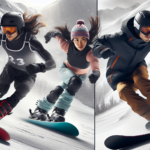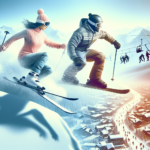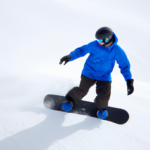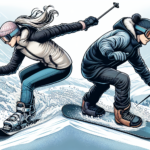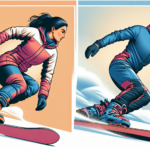Are you an adrenaline junkie looking to hit the slopes this winter, but uncertain which is the safer sport: snowboarding or skiing? This article lays out the key differences between the two beloved winter sports and weighs in on their safety aspects. We will provide an in-depth analysis based on factors like injury rates, safety equipment, learning curve, and more to determine which one might be the safer choice for you. Let’s embark on this journey to help you make the best, and safest decision for your next winter adventure.
Understanding the Fundamentals of Snowboarding and Skiing
Venturing into the world of winter sports can be quite exciting, but let’s start with understanding the basics. Two of the most popular recreational activities in this category are snowboarding and skiing. Knowing what these sports entail can get you excited and ready to hit the slopes!
Basic definition and concept of snowboarding
Snowboarding, at its core, involves descending down a snow-covered slope while standing on a snowboard. A snowboard is a flat board with bindings to secure your feet. Unlike skiers, who use two independent skis, snowboarders traverse the mountain attached to a single board. This sport is a blend of skateboarding, surfing, and skiing elements. It offers a unique sense of freedom and adrenaline that’s loved by thrill-seekers around the globe.
Basic definition and concept of skiing
Now, let’s move over to skiing. In this sport, you slide over snow using skis, which are long, thin pieces attached directly to your ski boots using a special binding. With one ski on each foot, the skier moves downhill, typically along a prescribed path or trail. Skiing is an exhilarating sport and can be performed either for leisure or competitively.
The evolution and history of both sports
Snowboarding and skiing, despite being distinctly different, share a similar heritage. Snowboarding, comparatively a younger sport, first hit the scene in the 1960s, a blend of skateboarding and surfing adapted for the winter landscape.
Skiing, on the other hand, has a long history that stretches back for centuries. Primitive skis were used thousands of years ago by Northern European and Asian civilizations as a means of transportation during the snowy winter months. It was only in the mid-19th century that skiing transformed into a recreational activity before evolving into the competitive sport that we know today.
Initial Risk Factors in Snowboarding and Skiing
As fun and exciting as snowboarding and skiing might be, they are not without risks. These sports require a fair amount of physical fitness and an awareness of potential hazards.
Physical demands and potential hazards in snowboarding
Snowboarding calls for a substantial amount of lower body strength and flexibility. Due to the attached board, it can be tough on the knees and ankles. Besides, the lack of independent leg movement increases the potential for falls and rotations, which could lead to serious injuries. Additionally, the nature of the terrain and unpredictable weather can also pose challenges.
Physical demands and potential hazards in skiing
Skiing demands a lot from your body as well. It requires excellent balance, core strength, and leg power to control your movement while hurtling down a slope. The risk factors in skiing primarily come from the speed at which skiers descend and the possibility of collisions. Also, similar to snowboarding, terrain and weather conditions can significantly affect the safety hazards encountered while skiing.
Importance of fitness level for both sports
Regardless of whether you are skiing or snowboarding, a strong fitness level is crucial. Due to the rigorous physical nature of these sports, your body needs to be prepared for the demands they impose. Conditioning exercises and regular training are vital to manage the physical stress and lower the risk of injury.
Common Injuries in Snowboarding
Injury is an inherent risk when snowboarding, especially for beginners. Let’s discuss some of the most prevalent injuries encountered on the slopes.
Wrist fractures and sprains
Wrist fractures or sprains are quite common in snowboarding. This is because your first instinct when you fall is to put out your hand to break the impact, which can often result in injury.
Ankle injuries
Ankle injuries are also regular occurrences in snowboarding. This is primarily due to the fixed position in the bindings and the constant torsional forces applied as you twist to control your direction.
Head injuries and concussions
Head injuries and concussions in snowboarding are less common but can potentially be more severe. These can occur from falls, jumps, or collisions with other snowboarders or obstacles.
Common Injuries in Skiing
Just like snowboarding, skiing has its share of common injuries as well.
Knee ligament injuries
In skiing, knee ligament injuries are very frequent. The bindings on skis release the boot during a fall to minimize injury, but sometimes they fail to release, straining the knee ligaments.
Broken legs and fractures
Broken legs and fractures, although less common than knee injuries, can still occur in skiing accidents. High-speed collisions or awkward landings from jumps are often the cause.
Head injuries and concussions
As in snowboarding, head injuries and concussions can also happen in skiing. These injuries often result from collisions with other skiers, trees, or from falls during risky maneuvers.
Understanding Safety Measures in Snowboarding
Having recognized the potential dangers, it’s crucial to understand safety measures in snowboarding.
Essential protective gear for snowboarding
One of the best ways to safeguard yourself when snowboarding is by wearing essential protective gear. Helmets, wrist guards, and padding for hips, knees, and tailbone are strongly recommended.
Importance of professional training and lessons
Professional training and lessons are also vital in preventing snowboarding injuries. Learning the correct techniques to navigate and control your board can significantly reduce your risk of serious injuries.
The role of slopes and terrain in snowboarding safety
The choice of terrain also plays a massive role in snowboarding safety. Beginners should start on moderate slopes and move up to steeper terrains only when they’ve developed the necessary skills and confidence.
Understanding Safety Measures in Skiing
Skiing, like snowboarding, demands appropriate safety measures to ensure that you enjoy the sport while minimizing the risks.
Essential protective gear for skiing
Protective gear in skiing is much like that in snowboarding. This includes helmets, ski gloves, and knee and elbow pads. Some skiers also choose to wear back protectors for added safety.
Importance of professional training and lessons
Professional training in skiing is equally important. Lessons from trained instructors significantly reduce the chances of accidents and injuries as they teach you about proper techniques, control, and how to fall safely.
The role of slopes and terrain in skiing safety
For skiing, choosing suitable slopes is crucial. Beginners should stick to designated beginner slopes until they gain more experience and are comfortable with more challenging terrains.
Analyzing Accident Statistics in Snowboarding and Skiing
To better understand the risks, let’s look into recent injury statistics related to these sports.
Recent statistics on snowboarding injuries
According to some studies, snowboarding tends to see a higher injury rate compared to skiing, with approximately four to six injuries per thousand participants per day.
Recent statistics on skiing injuries
Meanwhile, skiing reportedly sees a slightly lower injury rate, with about two to three injuries per thousand participants per day, according to recent statistics.
Evaluation of the severity and frequency of injuries in both sports
While injury rates can be lower in skiing, it doesn’t necessarily make it safer. The nature of injuries in both sports varies. Knee injuries, which occur more frequently in skiing than snowboarding, can be more severe and require longer recovery time.
Role of Experience in Snowboarding and Skiing Safety
When it comes to snowboarding and skiing safety, experience does play a critical role.
How experience affects safety in snowboarding
In snowboarding, experience can affect safety in many ways. Seasoned snowboarders are more likely to know how to fall safely, understand their limits, and have greater control over the board, reducing the potential for injuries.
How experience affects safety in skiing
The same can be said for skiing. Experienced skiers are better at managing speed, have more excellent control and knowledge of the terrain, and are less likely to push beyond their skill level.
The dangers of overconfidence in both sports
Despite the advantages that come with experience, there’s also a danger of becoming overconfident. Both skiers and snowboarders who overestimate their abilities can get themselves into dangerous situations, leading to severe injuries.
Comparing the Risks: Snowboarding vs Skiing
When debating whether snowboarding or skiing carries a higher risk, data alone doesn’t tell the whole story. A comparison requires a deeper understanding.
Key risk differences between snowboarding and skiing
Key risk differences lie in the nature of the two sports. Snowboarding generally poses a higher risk of wrist and ankle injuries, while skiing tends to see more knee ligament injuries.
Assessing which sport has higher injury rates
In terms of injury rates, snowboarding typically sees more injuries than skiing. However, severe injuries such as ACL (anterior cruciate ligament) tears are more common in skiing.
Understanding the nature of injuries in both sports
The nature of injuries differs between the two sports. In skiing, injuries often occur due to high-speed collisions or failed binding releases, while in snowboarding, injuries occur due to jumps, falls, and the twisting movements the sport demands.
Staying Safe on the Slopes: Practical Tips
Being aware of the risks involved in both sports, take note of these practical tips to stay safe on the slopes.
Best practices for snowboarding safely
For snowboarding, always wear your helmet and protective gear, take lessons from professional instructors, especially if you’re a beginner, and learn how to fall correctly to minimize injury. Additionally, know your limits and only ride terrains that suit your skill level.
Best practices for skiing safely
In skiing, wear your helmet and use gear that fits correctly. Take professional lessons, particularly if you’re a novice, and always stay in control of your speed. Knowing how to fall safely can also significantly reduce your risk of injury.
The importance of continuous learning and practice in both sports
Continuous learning and practice are vital to your safety, regardless of whether you ski or snowboard. As you gain experience, your ability to navigate different terrains and weather conditions improves, reducing your risk of injury. However, remember never to let overconfidence get the best of you. Stay safe, respect your limits, and enjoy the thrill these winter sports offer!
- What Snowboard Bindings Should I Get? - January 23, 2024
- What Size Screws For Snowboard Bindings? - January 23, 2024
- How To Snowmobile On Water? - January 23, 2024




